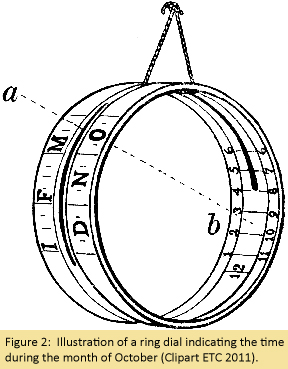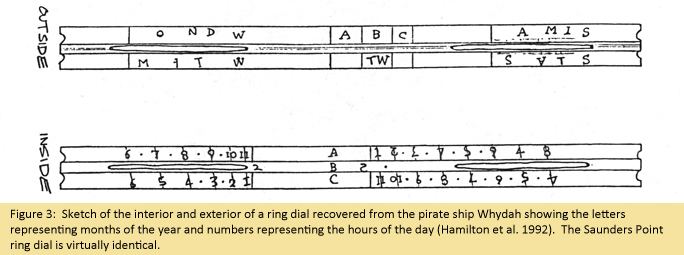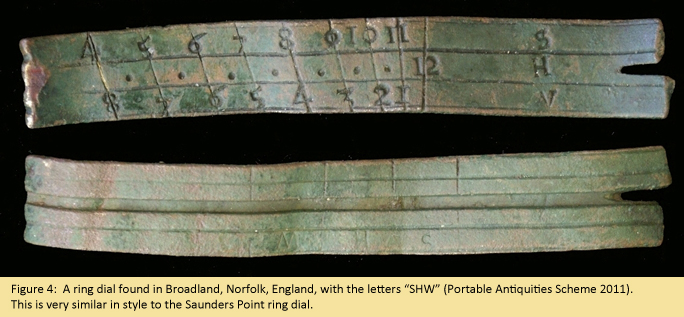"Set me right and use me well, and I to you the time will tell"*:
Timekeeping in the 18th Century
December 2011
By Rebecca Morehouse, MAC Lab State Curator
For thousands of years humans have recognized the passage of time, whether through the cycle of night and day or by the passing of the seasons. Our current method of timekeeping, which uses a 60-second minute, a 60-minute hour and a day divided into two 12 hour periods, originated over 4,000 years ago in Mesopotamia and Egypt (Barnett 1998: 102). The Ancient Egyptians built great obelisks to track the sun, creating the first sundials. In 600 BC, philosopher and astronomer Anaximander is said to have introduced the sundial to Greece and from there it grew in popularity and was the most trusted timekeeping device for centuries (Ostler 2003). Sundials still remained in use even with the invention of mechanical clocks, as early clocks were notoriously inaccurate and had to be regularly calibrated using a sundial.

Evidence of the use of sundials in colonial Maryland was uncovered in 1968 during salvage excavations of an 18th century cellar at the Saunders Point site, in Anne Arundel County. Saunders Point is likely the site of the plantation of Captain Robert Saunders, who lived along the South River in the 18th century. Archaeologists recovered a flattened copper alloy ring engraved with numbers and letters (Figure 1), which was identified by Richard Muzzrole, Curator of Cultural History at the Smithsonian Institution, as an 18th century English sundial, specifically, a ring dial (Israel 2006: 33).
 Around 1600, English mathematician Willam Oughtred invented the ring dial, a small portable sundial that quickly came into common use throughout Europe (Chandler and Vincent 1967: 156). It consists of a brass ring which, when suspended vertically and oriented towards the sun, can be used to determine the time of day (Eden and Lloyd 1900: 188) (Figure 2). The interior surface of the ring has numbers corresponding to the hours of the day and the exterior has letters corresponding to the months of the year. A narrow band of brass slides along a groove set in the exterior surface of the ring. The movable band has a hole in it, which can be aligned with the letters, or months, on the exterior of the ring. The hole in the band allows sunlight to pass through and strike the numbers on the interior surface indicating the time of day (Stephens 1851: 52).
Around 1600, English mathematician Willam Oughtred invented the ring dial, a small portable sundial that quickly came into common use throughout Europe (Chandler and Vincent 1967: 156). It consists of a brass ring which, when suspended vertically and oriented towards the sun, can be used to determine the time of day (Eden and Lloyd 1900: 188) (Figure 2). The interior surface of the ring has numbers corresponding to the hours of the day and the exterior has letters corresponding to the months of the year. A narrow band of brass slides along a groove set in the exterior surface of the ring. The movable band has a hole in it, which can be aligned with the letters, or months, on the exterior of the ring. The hole in the band allows sunlight to pass through and strike the numbers on the interior surface indicating the time of day (Stephens 1851: 52).
The ring dial from Saunders Point measures 1.2 cm wide and would have been roughly 5 cm in diameter before it was crushed. It is missing the narrow movable band and two small sections of the ring itself, but most of the numbers and letters are still readable even after two centuries in the ground. The Saunders Point ring dial is almost identical to one recovered from the pirate ship Whydah, which was lost in a storm in 1717 off the cost of Cape Cod, Massachusetts (Figure 3). Both the Saunders Point and Whydah ring dials have two separate scales of letters on the exterior surface of the ring. One scale is marked with a “W” and has letters for the winter months and the other is marked with an “S” and has letters for the summer months. This indicates the movable band would have had two holes rather than just one, so it could be used in both winter and summer.
There are other letters on the ring dial whose meaning has not been determined. Both the Saunders Point and Whydah ring dials both have the letters “TW” on the exterior of the ring. However, where the Whydah ring dial has the letters “ABC” (Figure 3), both on the exterior and interior of the ring, the Saunders Point ring dial has the letters “SHW”. A ring dial found in Broadland, Norfolk, England, also has the letters “SHW” on the exterior and interior of the ring (Figure 4). While the letters “TW” may be attributable to a maker, the location of the letters “ABC” or “SHW” on both the interior and exterior of the ring do not seem likely candidates for a maker’s mark.

The type of sundial found at the Saunders Point site would have been useful for travelers on land, but would have been particularly useful for telling time at sea. When suspended, a ring dial would remain steady with the rolling and pitching of a ship on the small ocean swells, which would allow for fairly accurate timekeeping on board ship. While archival research has not found evidence whether Robert Saunders' title of "Captain" indicated his position on board ship or his rank in the military, the discovery of the type of sundial so often used at sea is intriguing. It may very well indicate that Robert Saunders used it to assist with navigation at sea.

With the invention of more reliable mechanical clocks and more sophisticated navigational instruments, the sundial's use as a calibration or navigation tool was no longer needed. Today sundials are primarily used for aesthetic purposes, such as garden decorations.
* Quote engraved on a ring dial found in Oldbury Hill, Wiltshire, England (Cunnington 1887: 220).
| References |
|
| Barnett, Jo Ellen |
| 1998 |
Time's Pendulum: From Sundials to Atomic Clocks, the Fascinating History of Timekeeping and How Our Discoveries Changed the World. San Diego, CA: Harcourt Trade Publishers. |
|
| Chandler, Bruce and Clare Vincent |
| 1967 |
"A Sure Reckoning: Sundials of the 17th and 18th Centuries". The Metropolitan Museum of Art Bulletin 26 (4): 154-169. |
|
| Clipart ETC: An Online Service of Florida’s Educational Technology Clearhouse |
| 2011 |
Ring Dial Illustration. Electronic document, http://etc.usf.edu/clipart/27500/27597/ring_dial_27597.htm |
|
| Cunnington, F.G.S. |
| 1887 |
"Relics of Ancient Population on Oldbury Hill, Wiltshire". The Wiltshire Archaeological and Natural History Magazine 69 (22):213-221. |
|
| Eden, H.K.F. and Eleanor Lloyd, eds. |
| 1900 |
The Book of Sun-Dials. Originally compiled by Mrs. Alfred Gatty. London: George Bell and Sons. |
|
| Hamilton, Christopher E., Ph.D., Kenneth J. Kinkor, and David A. Muncher |
| 1992 |
The 1990-1991 Annual Report, Archaeological Data Recovery, The Whydah Shipwreck Site. South Chatham, MA: The Whydah Joint Venture Laboratory. |
|
| Israel, Stephen S. |
| 2006 |
Brass Astronomical Ring Dial (Sundial). Maryland Archeology 42 (1): 33-34. |
|
| Ostler, Elliott |
| 2003 |
"Sundials and Their Shady Past". Mathematical Connections: Exploring the Interplay Between Mathematics and the Humanities. Electronic document, http://www.aug.edu/dvskel/Ostler2003.htm. |
|
| Portable Antiquities Scheme/Department of Culture, Media and Sport, United Kingdom |
| 2011 |
Sundial. Electronic document, http://finds.org.uk/database/artefacts/record/id/400486. |
|
| Stephens, George |
| 1851 |
"Touchstone’s Dial". Notes and Queries: A Medium of Inter-Communication for Literary Men, Artists, Antiquaries, Genealogists, Etc. 3 (65): 52-53. London: George Bell and Sons. |
|